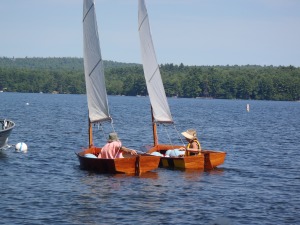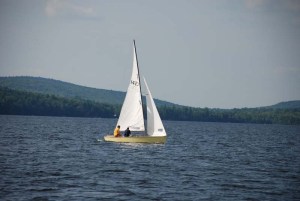After last weekend’s Hurricane Cup, in which the Commodore’s display of sailing prowess and skill led to an inevitable victory for the Lightning Dragonfly, a few club members (shockingly) started asking questions about handicap ratings: How do ratings work? How do boats in the fleet compare with one another?
Here is my defense answer:
Sailboat design is a tradeoff between multiple factors. Speed usually gives way to comfort. A boat that is easy to sail will often lack the ability to be fine tuned for a given condition.
Let’s look at the differences between a Lightning and an Alerion, for example: The Lightning has a large amount of sail area in relation to the weight of the boat. While this makes the boat powerful and fast, keeping it all under control requires constant adjustments in both sail trim and positioning of crew weight. Although rare, a Lightning can capsize if the crew is not on top of things.
The Alerion, on the other hand, has a smaller sail area compared to the boat’s weight. While this makes the boat less powerful and fast than a Lightning, it improves many other aspects: the Alerion is dryer, safer, easier to control — and, let’s face it, a lot better looking than the Lighting.
A handicapping system attempts to mathematically even-out the differences between boats in a fleet. Handicapping requires faster boats to give time to slower boats.
GPYC uses the Portsmouth Yardstick system, in which each boat class is assigned a rating, a number derived from multiple aspects of the boat’s design.
Ratings take into account, among other things, a boat’s designed sail inventory. If a boat was designed to sail with a spinnaker (like a Nomad), the rating assumes that the boat will sail with a spinnaker; likewise, if a boat is not designed to sail with a spinnaker (like a Precision 18), the rating assumes that the boat will not sail with a spinnaker. Allowing creativity with a boat’s sail plan, no rating deductions are given for flying a spinnaker on a non-spinnaker boat.
The Portsmouth Numbers Committee adjusts the rating numbers from year to year, based upon data submitted by participating clubs that send race results to the committee. For boats that have been around a long time (like the Lightning) the rating changes very little; but for boats that are relatively new on the market (like the Alerion), the rating is adjusted, if numbers measured in the field (average boat speed / average wind speed) do not match the boat’s predicted performance.
You can find your boat’s Portsmouth Yardstick rating here: Most of GPYC’s fleet is in the “Offshore Classes” category (except for the Lightnings and Nomads, which are in the “Centerboard Classes” category). Our club uses the ratings that appear in the “D-PN” column, which do not account for wind speed over the course.
The formula to correct the time is as follows:
Corrected time = Elapsed time x (100 / D-PN Rating)
If you remember high school algebra, the lower the boat’s rating, the more the corrected time increases over the elapsed time. So, a Lightning with a rating of 87.0 gives time to an Alerion with a rating of 93.7.
While the Lightning “Banana Slug” crossed the finish line second, with less elapsed time than the Alerion 20 “Take Five,” which crossed the finish line third, corrected time put Banana Slug in sixth place and Take Five in fourth.
Banana Slug: 1.454 x (100 / 87.0) = 1.671
Take Five: 1.502 x (100 / 93.7) = 1.603
| August 25, 2012 Hurricane Cup Results | ||||
| Boat | Type | Rating | Time (decimal) | |
| Elapsed | Corrected | |||
| Dragon Fly | Lightning | 87.0 | 1.255 (#1) | 1.443 (#1) |
| Minuet | Minuet | 113.4 | 1.672 (#6) | 1.474 (#2) |
| Echo | Precision 18 | 101.0 | 1.587 (#4) | 1.571 (#3) |
| Take Five | Alerion 20 | 93.7 | 1.502 (#3) | 1.603 (#4) |
| Hoyty Toyty | Nomad | 93.5 | 1.533 (#4) | 1.640 (#5) |
| Banana Slug | Lightning | 87.0 | 1.454 (#2) | 1.671 (#6) |
| Foggy Notion | Starwind 19 | 106.2 | 1.801 (#7) | 1.696 (#7) |
The Portsmouth Yardstick system is far from perfect; discussions usually turn toward which boats have the more advantageous ratings, rather than which sailors have the stronger skills.

El Toros “Ladybug” and “Bumblebee” are structurally identical. It remains to be proven that Ladybug’s racy red paint and hydrodynamic speed dots have a racing advantage over Bumblebee’s mellow yellow paint and hydro-resistant lateral stripes….
Most clubs offer some kind of single-design fleet for its serious racers. When everybody sails the same type of boat, the win is based purely on skill. Of course, discussions then usually devolve into who has the newer sails…. Until GPYC settles on a single-design class, I propose that, for the next race, we bring two identical boats with interchangeable sails and rigging. Any concerns (or whining) about ratings will be settled on the water…in El Toros!


Recent Comments